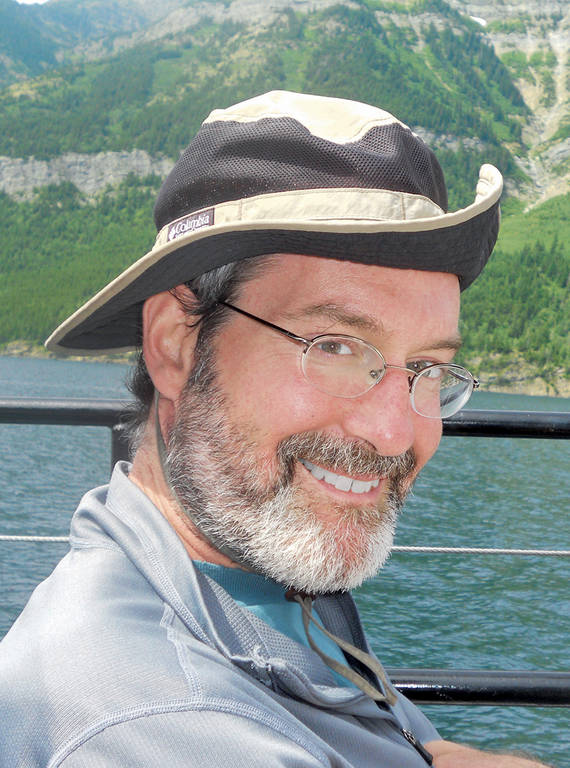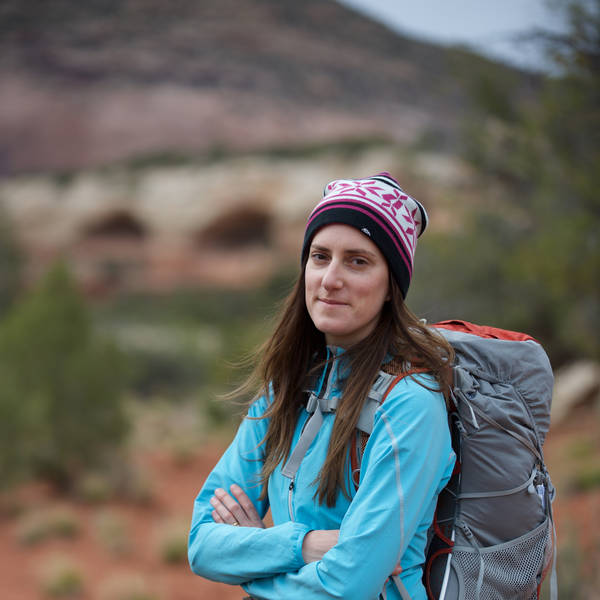Fall 2020
Final Words
A former Yellowstone ranger raced to finish a book about two threats — one that endangers national parks and another that ultimately took his own life.
Mike Yochim was an energetic young ranger when he visited Cache Creek for the first time in the summer of 1988. Back then, he was lanky and strong and falling in love with Yellowstone National Park. With every free moment, he ranged over the park’s vast wilderness areas, coming to know just about every peak and valley.
To Yochim, Cache Creek was special. It sang its beauty out loud. With a friend, he stayed overnight in a tiny patrol cabin and ambled the old forests of lodgepole pine, spruce and fir. Alive with springs and seeps and streams, the valley abounded with wildflowers — bright pink Lewis’ monkeyflowers, blue Columbia monkshood and wild geraniums in vibrant hues. Everywhere, it seemed, signs of life blazed and flowed.
But as he and his friend hiked out over a pass and a mountain, they looked back and saw a portent of future devastation. A plume of smoke, tinted an unnatural orange, billowed behind them. Back in town, Yochim learned that a wildfire had erupted and Cache Creek had been closed to visitors. Over the following weeks, blazes rampaged through the park. One day, in just six hours, 200-foot flames incinerated the backcountry paradise of Cache Creek.
Yochim didn’t realize it at the time, but this was his first known encounter with the effects of climate change. Both June and July had been unseasonably dry in 1988, and unusually strong winds fanned small wildfires into conflagrations. Even the area’s most seasoned firefighters hadn’t seen conditions that extreme. Since then, scientists have linked the increase in fire activity in the park in recent decades with warming temperatures and decreasing precipitation. Now they identify the fires of 1988, which burned more than a third of the park, as the first of the West’s modern megafires, a trend attributed largely to global warming. In the years and decades after Yochim’s brush with those fires, he started to experience other harbingers of climate change — dipping into Yellowstone Lake and finding the water surprisingly temperate or sloshing through the backcountry on skis on disturbingly warm winter days. The signs added up to a sense of dread, a feeling that something was wrong without a complete grasp of the threat’s scope.
In much the same way, Yochim came to understand the condition plaguing his own body. At first, in late 2012, he detected an unusual feeling in his throat. Then in early 2013, the muscles just under his skin started twitching, and his speech began to slur. No one else seemed to notice, but Yochim knew something was off. The first neurologist he saw chalked it up to stress. The anxiety medications, however, made his symptoms worse. Later, Yochim saw a neurologist at Stanford University who ran a litany of tests, ruling out many conditions, including a vitamin B12 deficiency, mercury poisoning and multiple sclerosis. What remained was arguably the worst possible outcome: amyotrophic lateral sclerosis or ALS. Also known as Lou Gehrig’s disease, the degenerative disorder affects the nerves in the brain and spinal cord. Patients slowly lose the ability to control all their muscles, effectively becoming entombed in their bodies “I’d rather have cancer,” Yochim told one of his three brothers after his diagnosis in September 2013.

Yochim on a trip to Glacier in 2014.
COURTESY OF JANET KURMAN HESSELBARTHAbout a year later, Yochim, then 48, moved in with his parents, Jim and Jeanne Yochim, who were still living in the house in a St. Louis suburb where he had grown up. As his body slowly came to a standstill, his daily rhythm transformed from near-constant adventure to quiet introspection. Over time, he lost the ability to move everything but his eyes and his mouth, which he could open just wide enough for his father to brush his teeth. Immobilized, he used a special computer system that tracked his eye movements, allowing him to type out one letter at a time, stringing together words and then sentences and paragraphs. He spent his days writing about the parks. In August 2019, Riverbend Publishing released his fourth book, “Essential Yellowstone: A Landscape of Memory and Wonder,” a collection of intimate portraits of the park. His next goal meant even more to him. He wanted to finish a book about how climate change was affecting the parks just as ALS was robbing his once vigorous body of all its beauty and capability.
In October, I traveled to St. Louis to meet Yochim and his family, arriving with two of his friends, Bill and Lynn Lowry, on a blustery fall day. The Yochims’ tidy home is located at the end of a peaceful cul-de-sac on the edge of a forest where deer and fox roam. Yochim was sitting in his wheelchair in a cozy living room with cheerful yellow walls, family photos and a small jungle of houseplants and cactuses. A wood fire blazed in a stove, and the jolly singsong of a cuckoo clock occasionally rang through the room. Because Yochim couldn’t move anything but his eyes and his head was held up in a brace, I squatted down so that he could see me properly as I introduced myself. Then, the five of us sat down on overstuffed couches as Jim fixed us cups of coffee.
The Dynavox, the machine that translated Yochim’s gaze into letters and words, allowed him to communicate well enough to get his needs met and have basic conversations, but tapping out one letter at a time was slow and took extraordinary patience. After I asked a question, it took 10 to 15 minutes for him to produce a couple of sentences and for the machine’s robotic masculine voice to read them out loud. In the meantime, the conversation rambled on without him.
“Michael loved to talk — I don’t mean too much — but he really just loved to talk,” Jeanne said. “He said a couple weeks ago that if he could get back one thing, it would be the ability to talk.” Yochim’s words were so precious and few that whenever the robotic voice erupted into the conversation, we all fell silent to listen.
Yochim called ALS an unrelenting and hateful disease, and I asked him what it was like to experience his body in this way. “I feel like I’m in prison sometimes,” he said. “Even solitary confinement.”
Once a voracious hiker and cross-country skier, he estimated that he had hiked more than 15,000 miles and skied more than 5,000 miles in his lifetime. Back then, he was an enthusiastic gourmand and impressive backcountry chef, wowing his hiking partners with dishes such as pasta with cream sauce, sun-dried tomatoes and peppers. Eventually, all of that was beyond reach. He was not only immobile, but he couldn’t even chew or swallow. Still, he didn’t stop enjoying the life he was able to lead. He still went to the symphony in his wheelchair. He decorated his room — a converted sun porch off the living room — with his photographs of national parks, maps and plaques commemorating the years he devoted to the Park Service. On nice days, he would sit in his parents’ garden and enjoy the suburban nature around him. One afternoon, he was sitting still as marble when a fledgling wren took its maiden flight and zoomed in for a rocky landing on his finger. “It righted itself and then looked right at me, then flew away,” he told me in an email. “Such a neat encounter with nature’s wildness, right in my backyard.”
Jim and Jeanne have a Midwestern can-do attitude, but caring for their son undoubtedly took a toll. They had expected to live out their retirement traveling but found they couldn’t leave their son alone and needed to arrange their own social engagements and doctor’s appointments around his schedule. And then there was the sadness and helplessness that came with watching Yochim navigate the cruelty of the disease, needing to ask for even the simplest things. “It tears at my heartstrings when he says, ‘Can you move my finger?’” said Jim, who operated the wheelchair most of the time and alternated with Jeanne to turn their son over several times each night.
The family had always been adventurous. As young parents of four sons, Jim and Jeanne road-tripped across the country and camped in parks from Shenandoah to Zion. Yochim’s earliest memory was an image of his dad losing his sunglasses in the Grand Canyon of the Yellowstone. On a trip to that park when Yochim was in his teens, his twin brother, Jim, said he thought park rangers were cool and he wanted to be one. Yochim didn’t know why, but the first thought that came to his mind was “You won’t, but I will.” He ended up spending nearly his entire career in Yellowstone as a ranger, guide and park planner who worked on snowmobile management among other projects.
Yochim loved Yellowstone from the beginning, but his appreciation for its rhythm deepened with time. His book, “Essential Yellowstone,” is a collection of remembrances, from watching a magnificent bison lumber through his campsite as if it owned the place to spying on a muskrat playing in shallow water. (It sneezed so cutely Yochim burst into laughter, alarming the little critter.) Over the years, he scaled peaks and skied to backcountry hot springs to see the otherworldly shapes they created in the snow. Sometimes, it was the smallest things that tuned him in to the texture of the place — the scent of sweet willows or the cries of a Clark’s nutcracker.
“It’s been five long years since I was in the West, the landscape that is so uplifting for me and many others,” he told me. “Not a day — indeed, hardly an hour — passes without my longing to be there.”
Yochim often spent his time reading or visiting with friends, but mostly, he wrote and researched material for his latest book, “Requiem for America’s Best Idea: National Parks in the Era of Climate Change.” He accessed the internet through the Dynavox technology, which allowed him to click, double-click and scroll with his gaze, and he emailed sources and prospective publishers. He kept a disciplined schedule, writing (on a good day) a couple of paragraphs in the morning and a couple in the afternoon.
Through the project, Yochim came to a much more intimate understanding of the sobering reality of climate change in the parks and beyond. In Yosemite, small mammals such as the pika and some bird species are already moving upslope — and may eventually have nowhere to go. In Grand Canyon, vast high-elevation forests, particularly pinyon pine stands, are dying. In Glacier, all of the glaciers have shrunk, with some diminishing by as much as 85% since 1966. Much of the Everglades will be inundated by 2100 because of sea-level rise.
“As the glaciers melt, forests burn, and wildlife move or die out across the West, all in the face of climate change, our collective memories of the unimpaired national parks will gradually fade, much like my increasingly distant recollections,” he wrote in his book. (Often in our email conversations, he copied and pasted excerpts from his book to save time.)
It wasn’t until he immersed himself in researching and writing his book that he realized the depth of the parallels between the disease that imperiled his own body and the human-made disease that threatens the Earth — the merciless parade of losses; the grief, anger and frustration; and the urgency that comes with knowing viscerally that there isn’t much time left. “If we don’t curtail our carbon emissions soon — and radically curb them — my experience may well become the universal experience,” he wrote in “Requiem.”
During my visit, I was struck by the intensity with which Yochim answered my questions. I noticed that sometimes a technology glitch would erase his words and force him to start all over again. His parents said that occasionally the calibration between the screen and his eyes malfunctioned and he would have to reset the whole thing. During my visit on that cold fall day, I asked what motivated him to work so persistently despite the frustrations and setbacks. “I think in part it’s because I believe we should pass on to our kids and grandchildren a world that is livable, lovable and beautiful,” he said. But it also was more personal, as I learned later through email conversations.
“One of the reasons I write is to avoid thinking about everything I’ve lost, including the abilities to talk, eat, walk, take care of myself and so much more,” he told me. “I can easily sink into a morass of deep depression. I take an antidepressant, which helps, but writing is probably more important in keeping me out of the depths of depression. It’s challenging and creative, and helps me escape the shackles of my body, at least for a while.”
Yochim hoped to finish “Requiem” and see it published this year. But in case he wasn’t able to, his friend, Bill Lowry, agreed to finish it for him. On February 29, in the early evening, Yochim was sitting at his desk writing an email when his heart stopped. His father was only 10 feet away and didn’t hear a sound. When he came over just before dinner, he noticed his son’s eyes were closed and he was unresponsive. He was gone.
Lowry now has Yochim’s manuscript. He fashioned the notes and bullet points into the conclusion and wrote the epilogue with Brian, Yochim’s brother. Lowry, along with Jim and Jeanne, is following up with potential publishers. They are determined to see the book published to honor Yochim’s memory. “It’s what he worked so hard for,” Jeanne said.

National Parks
You can read this and other stories about history, nature, culture, art, conservation, travel, science and more in National Parks magazine. Your tax-deductible membership donation of $25 or more entitles…
See more ›In “Requiem,” Yochim describes an acquaintance of his, Anne, who also had ALS. As she was deteriorating, her husband asked her if she wanted to continue to live even if she lost the ability to move her eyes. Believing a cure for ALS was imminent, she said yes. Eventually, she did lose the ability to move her eyes. She could still hear, smell and feel but had no way of communicating. Before he died, Yochim often wondered what she did to pass the time in the dark confinement of her head.
“Did she envision herself, as I would, on the shore of Yellowstone Lake, watching the setting sun highlight a departing storm while the tempestuous waves at my feet slowly calm? Could she sit on the fallen giant in Sequoia National Park’s Log Meadow, feeling the exuberance of summer life in that spot of heaven?” he wrote. “I hope she had some such place of tranquility and natural beauty, even if it was only the view from her deck. … This is, perhaps, the most important reason to prevent the worst of climate change, to save our places of wonder and inspiration, our citadels of safety, our retreats of renewal and transcendence. In saving our natural cathedrals, we’ll save ourselves too.”
About the author
-
 Kate Siber Contributor
Kate Siber ContributorKate Siber, a freelance writer and correspondent for Outside magazine, is based in Durango, Colorado. Her writing has appeared in National Geographic Traveler and The New York Times. She is also the author of “National Parks of the U.S.A.,” a best-selling children’s book.



